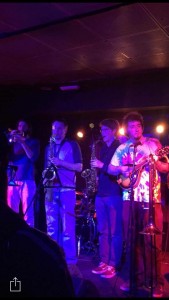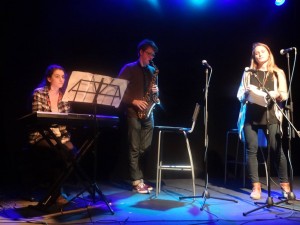It’s Thursday night at 12:30 a.m. and the crowd is just starting to build. Seated on stools, dancing and playing foosball is a large audience, all here for the weekly reggae jam session. It’s a mix of hippies, university students, foreigners and middle-aged people. There’s just no person that I could describe who is the average attendee. However, there is one thing everyone has in common, they move to the music, with a swaying body, clapping hand or tapping foot. The audience basks in the glow of the powerful horns, the funky bass and the singer who makes sure to wring every drop of emotion out of each note. All this happens at Boogaclub, an eccentric music club tucked away in the side streets of Granada.
Although a smaller city, Granada has amazing music with multiple concert venues. I had the opportunity to play twice a week at the Boogaclub jam sessions. It was a blast to hop up on stage, chat with the musicians and then play a few songs. Luckily, even when I couldn’t understand the music vocabulary in Spanish, I could follow the form and melody. Music genre also shifted by night and what was a jazz club the night before became an electronic music dance floor the next.
Granada’s busiest streets are also lined with musicians playing flamenco, funk, jazz and folk. As you move down Paseo de Los Tristes, a street mainly for foot-traffic that connects the downtown area to some of the smaller neighborhoods, the music reverberates off the walls and doors. Just as the echoes of a guitar fade away along the walk, a new sound of a violinist begins. This is all interrupted by the honking of an occasional impatient taxi driver who is trying to maneuver through the throngs of people.
Spain is also home to Flamenco music. Granada has an especially strong Flamenco tradition that grew in the caves of Sacromonte, one of Granada’s oldest and historically Romani (Gitano) neighborhoods. Gitano artists would host concerts in the caves and this concentrated hub of artists built Granada’s Flamenco scene that has continued to modern day. I was fortunate to see and hear a lot of Flamenco as many major celebrations in the city featured Flamenco performances. In addition, my Gitano friends at FSG, the organization where I interned, were full of recommendations of Flamenco artists that I needed to check out.
Flamenco reminds me what I love most about music. First off, there’s power and emotion in the music that conveys not just the story of the song but also the pure passion that the artists have for the music and dance. Secondly, there is an incredible level of musicianship that the dancers and musicians humbly demonstrate as they shift between time signatures, keys and complex rhythms. In addition, the dancers clap out rhythms as they listen to the music so that they are always connected and in the music, even if they aren’t dancing at that moment. Lastly, there is a deep connection between each artist performing as they lock into each other’s sounds and movements. For me, Flamenco was an eye opening new type of music that allowed me to examine the same things that I love about other genres of music in a new form.
When I first arrived in Granada, I was concerned that there might not be much music. However, I quickly found Granada’s music gems and also a space to keep practicing saxophone, allowing me to continue doing something that I really enjoy doing. Music is an integral part of Granada culture and I feel incredibly grateful that I chose this city to study in.

